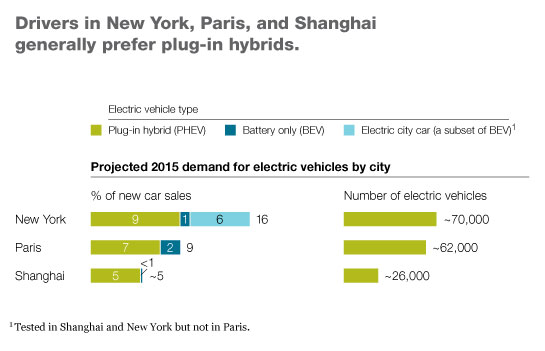As more and more electrified vehicles hit the floors of car dealerships, conventional wisdom has it that the market won’t get moving without richer incentives and dense battery-charging networks.
Yet our research on demand for electric cars in very large urban areas1 shows that plug-in hybrid electric vehicles and battery-only electric vehicles could account for 16 percent of overall new-car sales in New York, 9 percent in Paris, and 5 percent in Shanghai by 2015. That’s true even with today’s financial incentives and limited public charging facilities.2
It’s not surprising that the market may take root in big cities: nowhere is the need for cleaner air and reduced carbon dioxide emissions more pressing, and nowhere else can you expect to find as many green-minded early adopters who will welcome a clean vehicle that takes them the short distances they need to go on one charge. These characteristics make large urban areas the ideal labs for the next phase of electric-vehicle development. Our research offers insights that can guide auto companies, battery makers, infrastructure providers, and city governments alike as they consider moving forward with this technology and the networks that support it.
Large markets are waiting to be served. We found big clusters of potential early adopters—30 percent of all car buyers in Shanghai and 20 percent in New York—who were distinguished by their green thinking and would consider buying an electric car.
For early adopters, the charging problem isn’t as big as it seems. Unlike other groups of car buyers in New York and Shanghai, early adopters were willing to adjust their driving and parking habits to own an electric car. In fact, they indicated that a dense public charging infrastructure would only modestly increase their interest in buying such cars and that they were willing to cope with more limited charging options. This attitude reduces the need for public investments in the start-up stage, though a broad plug-in infrastructure will no doubt be critical as electrified vehicles migrate to mass adoption in large cities and elsewhere.
This is also good news for automakers, which have the opportunity to overcome another major obstacle: battery limits. Since many drivers in large cities travel only short distances—to and from work, for instance—the near-term cost and duration of electric-car batteries is less of a problem there than it is elsewhere. Rather than offering only all-purpose electric vehicles, automakers can segment buyers according to their driving missions and develop attractively priced models with no more battery energy storage than many of their city drivers need.
Technology preferences vary between cities. Shanghai buyers overwhelmingly preferred plug-in hybrid electric vehicles, which can drive some 60 kilometers (about 40 miles) on one charge and then switch to a gasoline-powered engine. The reason is the large share of first-time car buyers in Shanghai who demand family-size cars with full functionality. In New York, though, small electric city cars—a type of battery-only vehicle that can go 60 to 90 kilometers on a full charge—turned out to be very popular (exhibit).

Design matters, but in different ways. Most buyers in New York and Shanghai look for status: being the first with the latest technology and standing out from the crowd. But residents of Shanghai would like a novel and distinctive design, while New Yorkers prefer a more conventional design, albeit with the attributes that identify a vehicle as an electric car.
Nonfinancial incentives can be surprisingly effective. The smartest way to get the market going isn’t necessarily by increasing financial incentives. We found that monetary incentives, such as the US federal tax credit of up to $7,500 on the purchase of an electric car, will help stimulate initial demand. Yet raising them considerably will not lead to a quantum leap in adoption. In fact, among the 30 financial and nonfinancial measures we tested with New York consumers, some low-cost options—such as electric-vehicle-preferred lanes or conveniently located charging spots—were surprisingly effective.
Consumer education is one such measure that will be critical for catalyzing both early and mass adoption. Forty percent of New York and Shanghai respondents said they didn’t know much about electric vehicles and many were anxious about driving-range limitations. Few knew that battery-powered cars are relatively quiet and can potentially accelerate faster than conventional ones. And more important, many weren’t aware that electric cars help drivers save money on both fuel and maintenance in the long run.
So what comes next? Highly motivated private users in large cities such as New York and Shanghai—along with other potential early adopters, such as drivers of inner-city delivery vans with fixed routes—will be key to the electric-vehicle market’s longer-term development. By tailoring early products to the needs of these segments, automakers can build a strong base of core buyers whose use will spread word of mouth and drive market momentum. This approach, if supported with targeted actions by national and city governments, power providers, and battery makers, could accelerate the mass production and broad adoption of electric vehicles.
